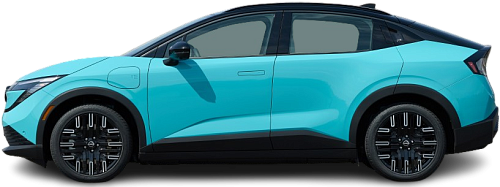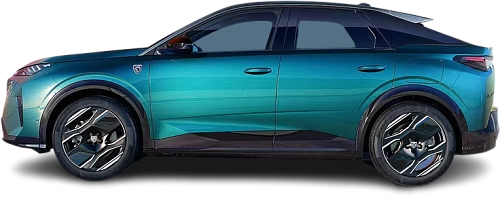Global EV Comparison: Nissan Leaf 75 kWh vs Peugeot e-3008 73 kWh FWD
Struggling to Decide? Let AI Help!
Your AI Summary Is Ready!
General Info
The Peugeot e-3008 73 kWh FWD (2024-…) is currently produced, it has a starting price of €48650. Although the Nissan Leaf 75 kWh (2025-…) has been announced, it is not yet in production and will not be available for sale in Europe.
The two vehicles share the same body style: SUV.
| Property | Nissan Leaf 75 kWh | Peugeot e-3008 73 kWh FWD |
|---|---|---|
| Years of Production | 2025-… | 2024-… |
| Current Status | Announced | Produced |
| Country of Manufacture | Japan, UK, USA | France |
| Body Style | SUV | SUV |
| Market Availability | EU, USA | EU |
| Price Europe (New) | - Price Europe (New) | €48650 |
| Price Europe (Used) | - Price Europe (Used) | €45449 |
| GCC Score | 5.9 | 6.3 |
Range and Efficiency
Even though the Peugeot e-3008 73 kWh FWD (2024-…) has a larger battery, the Nissan Leaf 75 kWh (2025-…) higher energy efficiency results in a longer real-world driving range.
| Property | Nissan Leaf 75 kWh | Peugeot e-3008 73 kWh FWD |
|---|---|---|
| Range (EPA) | 488 km | - Range (EPA) |
| Range (WLTP) | - Range (WLTP) | 525 km |
| Range (GCC) | 464 km | 410 km |
| Battery Capacity (Nominal) | 75 kWh | 77 kWh |
| Battery Capacity (Usable) | 71.2 kWh | 73 kWh |
| Efficiency per 100 km | 15.3 kWh/100 km | 17.8 kWh/100 km |
| Efficiency per kWh | 6.52 km/kWh | 5.62 km/kWh |
| Range and Efficiency Score | 8.4 | 7 |
Charging
Both vehicles utilize a standard 400-volt architecture.
The Peugeot e-3008 73 kWh FWD (2024-…) offers faster charging speeds at DC stations, reaching up to 160 kW, while the Nissan Leaf 75 kWh (2025-…) maxes out at 150 kW.
The Peugeot e-3008 73 kWh FWD (2024-…) features a more powerful on-board charger, supporting a maximum AC charging power of 11 kW, whereas the Nissan Leaf 75 kWh (2025-…) is limited to 7.2 kW.
| Property | Nissan Leaf 75 kWh | Peugeot e-3008 73 kWh FWD |
|---|---|---|
| Max Charging Power (AC) | 7.2 kW | 11 kW |
| Max Charging Power (DC) | 150 kW | 160 kW |
| Architecture | 400 V | 400 V |
| Charge Port | CCS Type 2 | CCS Type 2 |
| Charging Score | 5.1 | 6.5 |
Performance
Both vehicles are front-wheel drive.
The Nissan Leaf 75 kWh (2025-…) boasts greater motor power and accelerates faster from 0 to 100 km/h.
| Property | Nissan Leaf 75 kWh | Peugeot e-3008 73 kWh FWD |
|---|---|---|
| Drive Type | FWD | FWD |
| Motor Type | PMSM | PMSM |
| Motor Power (kW) | 160 kW | 157 kW |
| Motor Power (hp) | 214 hp | 211 hp |
| Motor Torque | 354 Nm | 343 Nm |
| 0-100 km/h | 7.1 s | 8.7 s |
| Top Speed | 157 km/h | 170 km/h |
| Performance Score | 3.7 | 3.5 |
Dimensions
The Peugeot e-3008 73 kWh FWD (2024-…) is longer, wider, and taller.
Both models have similar wheelbase lengths.
| Property | Nissan Leaf 75 kWh | Peugeot e-3008 73 kWh FWD |
|---|---|---|
| Length | 4405 mm | 4540 mm |
| Width (with Mirrors) | 2099 mm | 1895 mm |
| Width (w/o Mirrors) | 1810 mm | 1890 mm |
| Height | 1557 mm | 1641 mm |
| Wheelbase | 2690 mm | 2739 mm |
Cargo and Towing
The Nissan Leaf 75 kWh (2025-…) provides more cargo capacity, featuring both a larger trunk and more space with the rear seats folded.
Neither car is equipped with a frunk (front trunk).
The Peugeot e-3008 73 kWh FWD (2024-…) has a towing capacity of up to 1250 kg, whereas the Nissan Leaf 75 kWh (2025-…) is not officially rated for towing in the EU.
| Property | Nissan Leaf 75 kWh | Peugeot e-3008 73 kWh FWD |
|---|---|---|
| Number of Seats | 5 | 5 |
| Curb Weight | 1899 kg | 2083 kg |
| Cargo Volume (Trunk) | 565 l | 520 l |
| Cargo Volume (Max) | 1573 l | 1480 l |
| Cargo Volume (Frunk) | - Cargo Volume (Frunk) | - Cargo Volume (Frunk) |
| Towing Capacity | - Towing Capacity | 1250 kg |
| Cargo and Towing Score | 5.8 | 6.7 |




